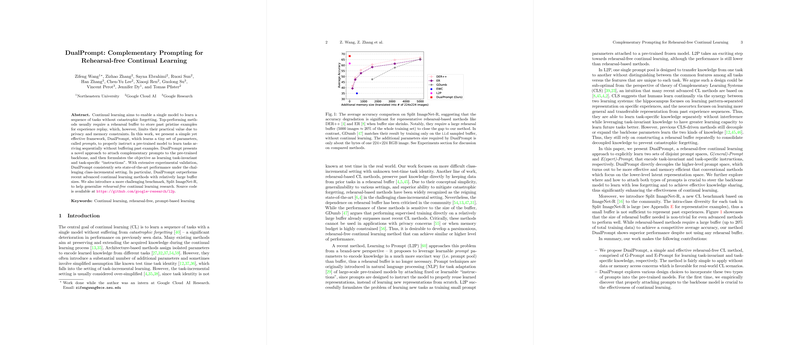DualPrompt: Complementary Prompting for Rehearsal-Free Continual Learning
The paper "DualPrompt: Complementary Prompting for Rehearsal-Free Continual Learning" presents a novel approach to addressing the problem of catastrophic forgetting in continual learning (CL) without relying on rehearsal buffers. This method is particularly relevant for settings where privacy and memory constraints are crucial, such as in real-world deployment. The innovation of the paper lies in the DualPrompt framework that consists of two types of prompts: G-Prompt and E-Prompt, which serve to harness task-invariant and task-specific knowledge, respectively.
Background
Continual learning aims to enable models to learn from a stream of tasks, avoiding the typical degradation in performance on previously learned tasks known as catastrophic forgetting. Many previous approaches have employed rehearsal buffers to retain past data, enabling experience replay which often comes with privacy concerns and significant memory requirements. Other approaches include regularization and architecture-based methods, each with their limitations.
DualPrompt Framework
DualPrompt sets a new direction by employing a prompting mechanism within a pre-trained transformer backbone. This method attaches complementary prompts to the model:
- G-Prompt (General Prompt): Shared across tasks, G-Prompt captures and instructs the model to leverage task-invariant features.
- E-Prompt (Expert Prompt): Task-specific prompts are applied to learn distinct task-specific features, which are activated through a key-query matching mechanism.
By decoupling these prompts at different layers of the neural network, the DualPrompt method is able to facilitate better representation and retain previously learned information without requiring rehearsal of past data.
Numerical Results
Extensive experimental validation demonstrates that DualPrompt outperforms state-of-the-art rehearsal-based and rehearsal-free methods in a challenging class-incremental setting:
- On benchmarks like Split CIFAR-100 and the newly introduced Split ImageNet-R, DualPrompt achieved superior average accuracy and reduced forgetting levels compared to methods requiring rehearsal buffers of up to 5000 images.
- It effectively surpasses other methods that do not use rehearsal, such as L2P, showcasing an improvement of 3%-7% in average accuracy.
Implications and Future Work
DualPrompt provides significant theoretical and practical advancements for developing continual learning systems that are privacy-preserving and memory-efficient. The use of pre-trained models allows the system to be both lightweight and high-performing, setting the stage for further research into modular and prompt-based learning strategies.
Future developments can explore enhancing the task-query mechanisms and integrating other prompting functions or architectures. Additionally, refining key-instruction matching and examining the impacts of different types of network architectures beyond transformers can provide further insights and improvements in this domain.
Conclusion
The DualPrompt framework presents a significant step forward in the rehearsal-free continual learning field, demonstrating how thoughtfully designed prompting mechanisms can alleviate forgetting without the need for extensive memory storage for past data. Its success highlights the importance and potential of leveraging pre-trained models within the CL context, a trend likely to influence future research and applications in artificial intelligence.
